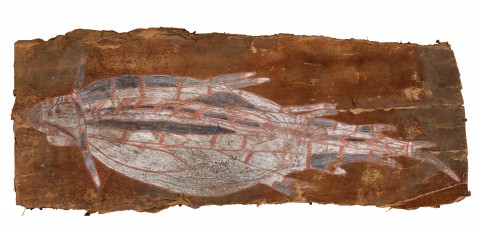UNTITLED (BARRAMUNDI)
ARTIST'S NAME NOT RECORDED (WEST ARNHEM LAND)
natural earth pigments on eucalyptus bark
65.5 x 160.0 cm (irregular)
Most likely produced in the first half of the twentieth century
Acquired at an Antiques Gallery in Unley Road, Unley, South Australia in 1965
Estate of Mr. Gary Bradley, Melbourne
Thence by descent
Private collection, Victoria
Paintings on sheets of eucalyptus bark that formed the walls of bark shelters, in effect murals, are the likely precursors to the tradition of portable bark paintings from Arnhem Land and adjacent regions in the top end of the Northern Territory. In fact, some of the earliest bark paintings to be collected by Europeans – at Port Essington on the Cobourg Peninsula between 1838 and 1878 – were taken from the walls of bark huts. Two of these entered the collection of the British Museum in the mid-nineteenth century1, while four are in the collection of the Macleay Museum, University of Sydney.2
The antiquity of the practice of bark painting in Arnhem Land is difficult to determine given the ephemeral nature of the materials used – namely, sheets of eucalyptus bark carrying images in paint made from ochres, charcoal and clay, and mixed with natural binders such as the sap of orchid plants or egg yolk. The lack of early examples of bark paintings is exacerbated by the custom of abandoning bark shelters with the seasonal movement of people across the clan estate, leaving the materials subject to the elements in a tropical environment.
The few extant examples of bark shelter paintings tend to depict ancestral beings, spirits, flora and fauna in a stylized, figurative manner. Some figures are decorated in geometric clan designs, while others in the X-ray style of drawing that is a feature of the pictorial art of West Arnhem Land and the Kakadu region. The spirit figure in lot 11 is painted in this style. The figure appears to be wearing a feathered headdress that associates it with ceremony, and the drawing of the vertebrae suggests three-dimensionality, a type of rendition which is rare in the art of the region. The image of the barramundi in lot 10 is another outstanding example of the X-ray style; here the backbone and some of the internal organs of the fish are clearly defined. Note too that the optic nerves are shown. By way of contrast, the animated figures of the barramundi and the turtles in lot 11 are painted in silhouette and drawn to suggest movement.
Paintings on the walls of bark shelters were made for a variety of reasons and were often didactic images that related to ancestral and ceremonial activities, and to the world of natural species.
A photograph, taken about 1924 by the renowned Australian explorer Sir George Hubert Wilkins (1888 – 1958), shows a series of paintings on sheets of bark from a shelter in the Glyde and Goyder Rivers area in north-central Arnhem Land that depict images of frill-necked lizards, fish, a kangaroo, long-necked turtles and human or spirit figures in a style similar to the images in these two paintings.3 At the time, Wilkins was making a study of bird life in northern Australia on behalf of the British Museum.
1. Coates, I. et al, Encounters: Revealing stories of Aboriginal and Torres Strait Islander objects from the British Museum, National Museum of Australia Press, Canberra, 2015, p. 77
2. Davies, S.M. with R. Stack, Collected: 150 Years of Aboriginal Art and Artifacts at the Macleay Museum, The University of Sydney, Sydney, 2002, pp.19 – 20
3. Mundine, D. et al, They are Meditating: Bark paintings from the MCA’s Arnott’s Collection, Museum of Contemporary Art, Sydney, 2008, p. 40
WALLY CARUANA
